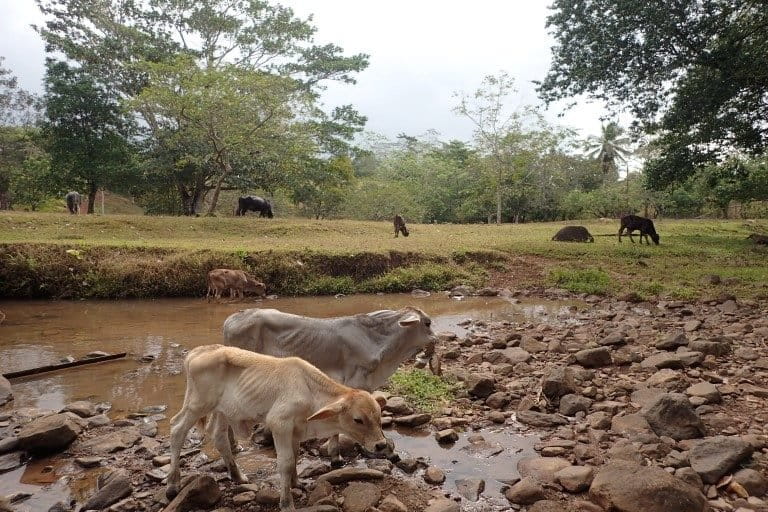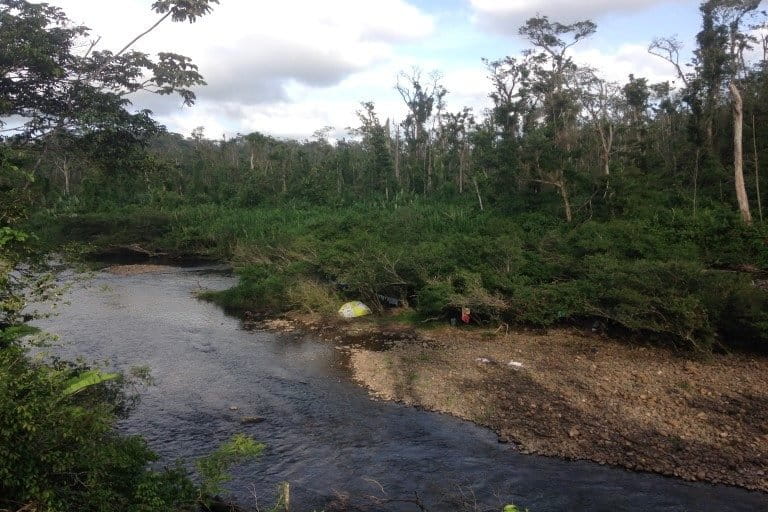Deforestation from cattle ranching also hurts rivers in Nicaragua, study says
Oct 22, 2021
- A new study highlights the adverse effects that cattle ranching has had on rivers in Nicaragua’s Indio Maíz Biological Reserve, including decreased food sources for aquatic life and the reduction in the size of fish.
- Deforestation has plagued the reserve for more than 30 years, resulting in the destruction of rainforest for cattle ranching, logging and other illegal activities.
- Local Rama and Kriol communities are carrying out patrols and starting other efforts to protect their land.
Cattle ranching has been destroying the Rama-Kriol territory in southeast Nicaragua for decades. And while many researchers have called attention to the devastating forest loss taking place there, few have focused on another, often-overlooked victim: the rivers.
A recent study published in the journal Hydrobiologia shows that deforestation from cattle ranching is taking its toll on the area’s watersheds, with noticeable erosion and decreases in biodiversity where forest loss is most prominent.
“We hoped that this study would highlight the impressive intact river systems and provide evidence for where illegal cattle ranching has destroyed rivers and their fisheries,” said study co-author Joel Betts from Michigan State University. “Hopefully, it serves as a call to action to protect the area.”
The Rama-Kriol territory is home to nine Indigenous communities that live in and around the 316,720-hectare (782,630-acre) Indio Maíz Biological Reserve and several other nearby protected areas. Since the late 1980s, colonos, or colonists, have settled there to hunt, harvest timber and raise cattle, among other illegal activities.
Between 2001 and 2014, 2,434 hectares (6,015 acres) were deforested in Indio Maíz, according to Mongabay’s previous reporting.

At the peak of the deforestation, Nicaragua’s Ministry of the Environment and Natural Resources (Marena), which didn’t respond to a request for comment for this story, reduced and even eliminated its personnel in many parts of the reserve.
Conservation organizations like Re:wild helped the local communities develop ways of protecting the area, such as organizing patrols. But the community said it wanted more data on how the invasions were impacting its home. Specifically, it wanted to know how they were damaging rivers and streams.
“The local community had a desire to document these things and I think that’s important,” said study co-author Gerald Urquhart, associate professor at Michigan State University. “Hopefully other scientists think about that. How do we respond to the local community instead of constructing our own studies?”
Betts went down to Nicaragua in 2018 to conduct the study during the dry months between February and April, when it’s easier to move through the rainforest. Because so much of the area has been deforested, he had to travel for days in canoes and river boats to reach watersheds untouched by cattle ranching.
During his study, he found that the longer the areas around a watershed had been deforested, and the more extensively they had been deforested, the more damage there was to the watershed. In general, deforested areas had a lower level of biodiversity, especially for small insects. He also found that fish populations — such as the machaca (Brycon behreae) and guapote (Parachromis dovii) — were smaller in size than those found in waters without deforestation.
“Many of the fish are eating aquatic insects,” Betts said, “which we found are becoming less abundant the more deforestation occurs. So fish are losing their food resources.”
Without the forest to slow down heavy rains, soil erosion has increased in rivers and streams near cattle ranches. The sedimentation fills in the cracks and crevices of riverbeds that insects need to live and that fish use to lay their eggs. The rain can also quickly turn into flash flooding that scours the bottom of rivers and washes fish and insects downstream.
Cattle herds tend to bathe in the streams, creating trenches where they come and go, which adds to soil erosion. And if the cattle are sprayed for ticks and other pests, these chemicals wash into the water and kill aquatic species.

Deforested areas around the water bodies also tend to stay deforested when cattle are present because they graze on and stomp out regrowing vegetation. The lack of trees and shrubs growing on the riverbanks can be disastrous for aquatic ecosystems.
“Most of the base of the aquatic food chain comes from that strip of trees within 100 meters [330 feet] of the stream bank,” Betts said. “It’s there that you have leaves, logs and bugs that fall into the stream — all important foods and habitat for invertebrates and some fish.”
Betts carried out the study at the same time he was doing preliminary investigations into river pollution connected to the poison-fishing practices of land invaders. Locals had come across large quantities of dead fish and makeshift log dams — both signs of a fishing practice that involves pouring pesticides into the water.
Some residents had gone blind and become sick from fishing and drinking from the river, Betts said. Others lost their livestock.
Since that investigation, Re:wild and Rama and Kriol communities launched a local campaign to raise awareness about the use of pesticides in the water. While it may be more complicated to stop the problems created by deforestation, Betts said they hope to try.
“I would love it if we could do more educational outreach and campaigning about how cattle ranching is affecting fisheries, and how the agricultural frontier is impacting native wildlife and fish, and the traditional communities they support,” he said. “That would be really great.”
Citation:
Betts, J. T., Urquhart, G. R., Román-Heracleo, J. & Flores Mc.rea, J. C. (2021). Effects of deforestation from cattle ranching over time on protected rainforest streams in the Rama-Kriol Territory, Nicaragua. Hydrobiologia. doi:10.1007/s10750-021-04684-w
Banner image: Cattle wander near a stream in the Rama-Kriol territory in southeast Nicaragua. Image by Nick Hawkins.
FEEDBACK: Use this form to send a message to the author of this post. If you want to post a public comment, you can do that at the bottom of the page.